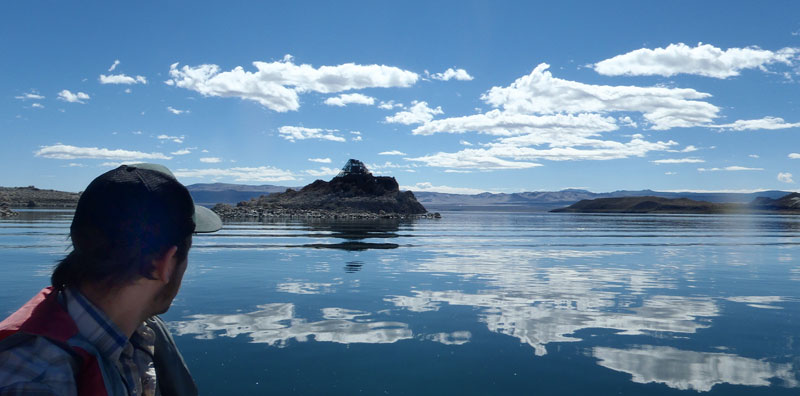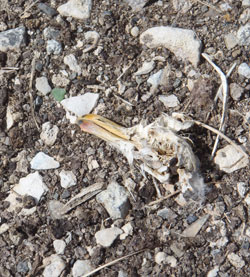
This post was written by Max Henkels, 2012 Mono Lake Intern.
In early September I had the privilege of joining PRBO Conservation Science researcher Kristie Nelson and small group of volunteers in an excursion to Mono Lake’s islets for the annual California Gull mortality count (otherwise known as the “Mort Count”).

This was the third and final trip that the gull researchers made to the islands this summer. In July, Birding Intern Erica Tucker helped out with chick-banding in a trip she chronicled last month on the Mono-logue. My experience on the islands was much different from hers, however….
The Mort Count involves combing every square foot of the islet, clambering over tufa-encrusted boulders, and picking through greasewood to check for dead gulls. Moving in concentric rings around the islets, we checked the feet of each carcass for bands. This often involves turning over the nearly decayed bodies (or, as one volunteer enthusiastically called it, “flipping flatties”), digging out their contracted little legs, and collecting the metal bands. Since each banded chick has a unique number, Kristie uses the bands to track how many chicks successfully fledged and how many died on the islets.
If the idea of flipping over gull carcasses doesn’t sound appealing, you should first consider the alternatives. Before going out to the islets, I had heard that the Mort Count was actually the most pleasant time to be out there. For starters, the absence of adult and fledged gulls (which have already migrated back to the coast) means relief from their constant release of bodily fluids. Contrasted with the messy chaos of thousands of birds, flipping over desiccated chicks seems relaxing by comparison.
As you start to examine the carcasses, however, another, much darker reason becomes apparent. The vast majority of dead chicks on the islands exhibit serious head trauma, wounds that result not from predation but the vicious territoriality of their own species. Seeing the remains of dozens of brutalized chicks is enough to dispel any benign notions about the harmony of nature.

The death of an adult means its chicks will almost inevitably die, as newborn gulls need one parent to hunt for food and another to constantly guard the nest. Without this protection, its neighbors will rarely miss a chance to kill the unattended chicks.
Not all chicks we found were victims of gull aggression. Some carcasses were torn to pieces, evidence of Great Horned Owls and other aerial predators. Other gulls died in apparent accidents, trapped in the greasewood brush or pinned under fallen rocks. Perhaps the saddest case we found was an adult wrapped in fishing line that had somehow made its way back to Twain Islet before dying.
The second component of our mission to the islands was to repair the nest plots for next season. These same plots have been used since the gull-banding program began in the 1970s and the decade-old perimeter is formed by a patchwork of fencing from different materials and years. Removing eroded wire and adding gates to allow chicks to wander from the plots were the main improvements we made for next season.
As an intern, participating in the Mort Count gave me an incredible opportunity to experience the lake from a new perspective. If you look scratch under the apparent desolation of the islands, the resilience and resourcefulness of life is incredible. Great Horned Owls now nest in an abandoned goat ranch on Paoha Island, gulls tote half-eaten BBQ ribs and trash miles from town to feed their chicks, and colonies of ants somehow survive on an islet containing nothing but dried scraps of birds and a lone, gnarled greasewood. Separated from the mainland by miles of brine, the Mono Lake archipelago truly comprises a bizarre world of its own. Yet, closing your eyes to the chirping of crickets and the gentle hooting of an owl, it feels far from the “loneliest tenant of the loneliest spot on Earth.”
